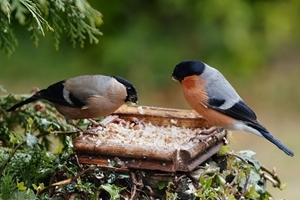Bullfinch
 A male bullfinch (Pyrrhula pyrrhula) has to be one of the UK’s most stunning birds, that is if you can spot him! Bullfinches love thickets of dense scrub and thorn, where they skulk around, very much keeping themselves to themselves. Sometimes the only way to know that they are around, is by tuning into their quiet, rather plaintive series of jumbled ‘rusty hinge’ noises that pass for their song.
A male bullfinch (Pyrrhula pyrrhula) has to be one of the UK’s most stunning birds, that is if you can spot him! Bullfinches love thickets of dense scrub and thorn, where they skulk around, very much keeping themselves to themselves. Sometimes the only way to know that they are around, is by tuning into their quiet, rather plaintive series of jumbled ‘rusty hinge’ noises that pass for their song.
But, WOW – when he does appear, what a bird! He has a shiny black cap, bluish black wings and tail, and a white rump, which is particularly noticeable when flying. However, I feel that it is the contrast of the jet black cap with the striking blush rose pink of the breast and cheeks that sets this spectacular bird apart from others. Females, despite lacking the rather flashy pink of the male, are also extremely attractive, with a pale brownish buff-coloured breast and cheeks.
Bullfinches are currently listed as an ‘amber’ species of conservation concern because of breeding population decline, with numbers declining particularly between 1977–82. However, the decline eased during the mid-1980s and, actually, numbers have now begun to rise again.
The female lays four to six bluish eggs with purple blotches at the larger end, in a nest that appears to be constructed almost in two parts. The base is a platform of small twigs and acts as the foundations for the nest itself, which is made mainly of moss and lichens and then lined with a thick layer of fine roots. The normally rather retiring parent birds become even more shy and completely silent when in the vicinity of the nest. As the nest is usually very well hidden away in a tangle of dense scrub, they can be extremely difficult to locate.
In the past, bullfinches were shot, especially in late winter and spring time, because of their penchant for eating the fresh new buds from a wide range of bushes and trees, especially fruit trees such as apples and pears. Also, village lads or indeed students were often paid to wander around the orchards of Kent, blowing various musical instruments and clattering dustbin lids together to frighten off the colourful pest! (A head of project scientist currently working at the GWCT used to do this to boost his university allowance!)
I know of an increasing number of people who have these beautiful birds coming into their gardens over-winter to eat seed that they have put out on their bird tables or in hanging bird feeders. They particularly love sunflower seeds or ‘heart’.
Have I ever had one on my feeders? In a word, no! I see them in my garden on frequent occasions, but they ignore (almost with contempt!) the sunflower seeds that I put out in feeders, hoppers, on platforms and on the ground! I do also position these near to thick cover, as bullfinches are wary of venturing too far out into the open. Yet I know that not far away, in gardens in the next village, they are tucking in to sunflower seeds like no tomorrow!
Ornithologists believe that an individual bullfinch can learn from other bullfinches that these feeders are good for a meal. Once one individual has learnt what they are for, others will observe and then join in. But you need a local bird to demonstrate how it is done. Because bullfinches are extremely sedentary birds, this might be the reason why some folk have bullfinches using feeders, while other people like myself, not that far away, have no visits whatsoever!
For the older ones of you reading this, you might remember how blue tits used to open up the milk bottle tops to drink the thick cream from the neck of the bottle. This was taught behaviour too, which quite rapidly spread through the blue tit population.
Bullfinches are nearly always seen as a couple, as it is believed they pair for life. I explained in the first paragraph how they will rather quietly ‘sing’ their unmusical notes to each other, reinforcing their pairing bond. Well, some people have taken young bullfinches, particularly in the forests of Germany – which, I hasten to add, is illegal in this day and age in this country – and spent lots of time bonding with them and getting them to repeat whistled tunes. They did this, as a good individual bird could earn them some extra money. The results are nothing short of astonishing!
Take a few minutes to go to this link and have a listen. It will play you the normal song of the bullfinch and then follows up with what you can train a besotted bullfinch that has paired with you to whistle or sing. Enjoy!
Peter Thompson
Advisory
Photo credit: Steve Polkinghorne